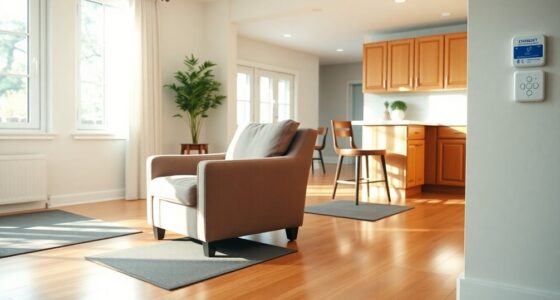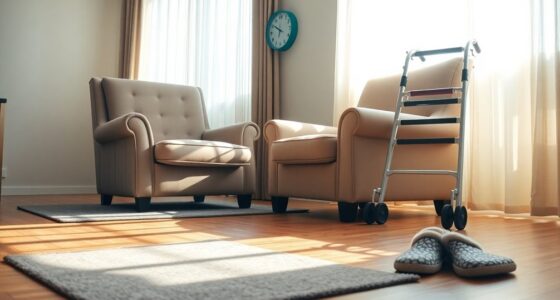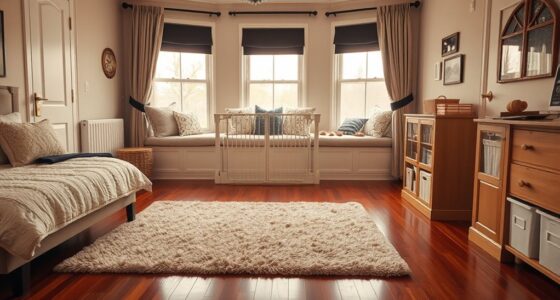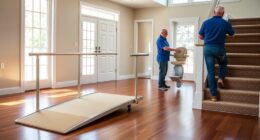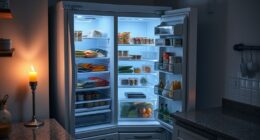To guarantee kitchen fire safety, always shut off appliances and unplug devices when not in use, and install automatic shut-offs to prevent overheating. Use non-slip, heat-resistant mats near sinks and stoves to prevent slips and burns. Designate a safe microwave zone away from flammable items, and avoid metal or unsafe containers inside. Keeping your space organized and well-maintained minimizes hazards. More tips await to help you create a safer kitchen environment.
Key Takeaways
- Turn off appliances and unplug electronic devices when not in use to prevent electrical fires.
- Use non-slip, heat-resistant mats near sinks and stoves to reduce slip hazards and protect flooring.
- Keep kitchen pathways clear of clutter to allow quick evacuation and safe movement during emergencies.
- Avoid leaving microwaves unattended and never use metal objects inside to prevent sparks and fires.
- Regularly inspect and maintain appliances and cords to identify and fix potential fire hazards promptly.
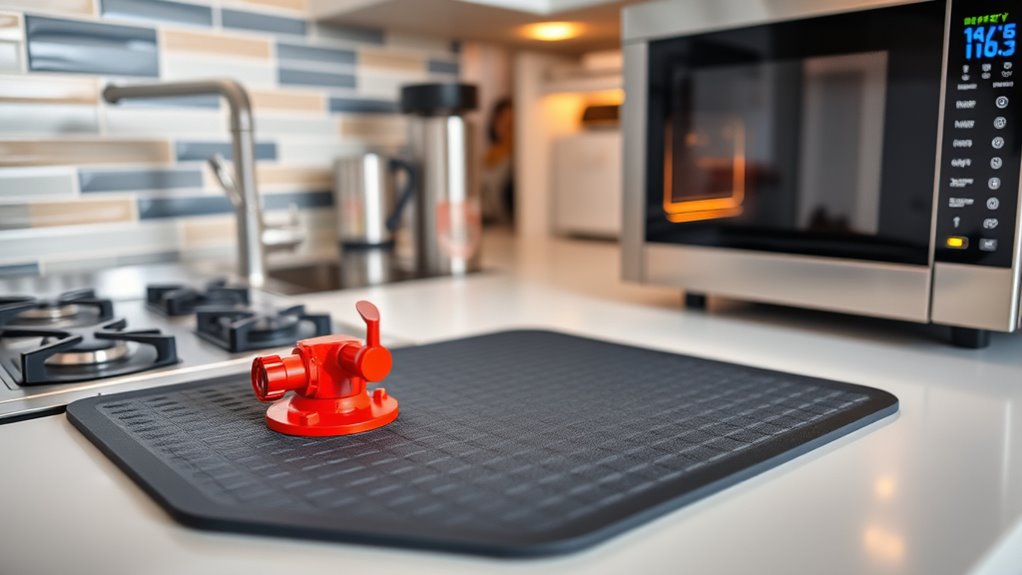
Cooking is one of the leading causes of house fires, but many accidents can be prevented with simple safety measures. One of the most effective steps you can take is making sure that all appliances and electrical outlets are properly shut off when not in use. Always double-check that your stove or oven is turned off before leaving the kitchen, even if you just plan to step out for a moment. Installing automatic shut-off devices can add an extra layer of safety, especially if you tend to forget or get distracted easily. These devices automatically cut power to appliances if they’ve been left on for too long, reducing the risk of overheating and potential fires.
Another critical safety feature to think about is the use of mats in your kitchen. Place non-slip, heat-resistant mats near your sink and stove to prevent slips and falls, which can lead to accidents involving hot surfaces or sharp objects. These mats also help protect your flooring from spills and stains. Make sure the mats are kept clean and dry, as wet or greasy mats can become slippery hazards. If you have children or pets, consider using special stove burner covers or mats that prevent accidental ignition or contact with hot surfaces. Keeping your floor clear of clutter not only reduces tripping hazards but also ensures you can move quickly and safely in case of an emergency.
Microwave zones are another essential aspect of kitchen fire safety. Microwaves are generally safe, but they can become fire hazards if misused. Never operate a microwave with metal objects inside, and avoid overloading it with food or containers that aren’t microwave-safe. Keep an eye on your microwave while it’s in use, and don’t leave it unattended for extended periods. When cooking or reheating, make sure the area around the microwave is clear of paper towels, plastic wrap, or other flammable materials, as these can catch fire if they come into contact with the microwave’s interior or heating element. Regularly inspect the microwave’s power cord and plug for damage, and replace any worn or frayed parts immediately to prevent electrical sparks. Additionally, proper maintenance of your kitchen appliances can significantly reduce fire risks.
Frequently Asked Questions
How Often Should Kitchen Fire Safety Equipment Be Inspected?
You should inspect your kitchen fire safety equipment monthly to guarantee everything works properly. Regular checks include testing fire extinguishers, inspecting shut-off valves, and ensuring safety mats and microwave zones are in good condition. Additionally, replace or service equipment annually or as recommended by the manufacturer. Staying proactive helps prevent fires and ensures you’re prepared in an emergency, giving you peace of mind while cooking.
What Are the Signs of an Impending Kitchen Fire?
A storm brewing in your kitchen often whispers through flickering lights, a persistent burning smell, or smoke gathering like dark clouds. You might notice grease sizzling or flames flickering at the stove’s edge. Stay alert to these signals, because they’re the siren call of an impending fire. Ignoring them is like ignoring the darkening sky before a storm—you risk getting caught in its fury if you don’t act swiftly.
Can Microwave Zones Be Combined With Other Safety Measures?
Yes, you can combine microwave zones with other safety measures for better protection. Make sure to keep the microwave area clear of clutter and flammable materials. Use fire-resistant mats nearby and install automatic shut-offs if possible. Regularly inspect your microwave and surrounding zones, and stay attentive when cooking. Combining these measures creates a safer environment, reducing fire risks and ensuring you respond quickly if something goes wrong.
Are There Specific Mats Recommended for Commercial Kitchens?
You should choose non-slip, fire-resistant mats made specifically for commercial kitchens. I once saw a chef slip on a greasy mat that nearly caused a fire hazard—highlighting the importance of proper safety gear. Look for mats with high flame resistance, easy cleanup, and durability to withstand heavy traffic. Investing in the right mats helps prevent accidents and keeps your kitchen safer, just like a sturdy foundation supports a strong building.
What Is the Most Common Cause of Kitchen Fires?
The most common cause of kitchen fires is unattended cooking. You might leave a stove or pan unattended, and this can quickly lead to a fire if the contents overheat or ignite. Always stay in the kitchen while cooking, keep flammable items away from heat sources, and use timers to remind you to check on your food. These precautions help prevent fires and keep your kitchen safe.
Conclusion
So, now that you know the secret recipes for avoiding kitchen fires—shut-offs, mats, and microwave zones—there’s really no excuse to play chef with danger. Remember, a fire in the kitchen isn’t part of the dinner party plan, unless you’re aiming for a smoky ambiance. Stay alert, keep your safety tools handy, and maybe, just maybe, keep the fire extinguisher closer than your spatula. Happy cooking—fire-free, of course!


